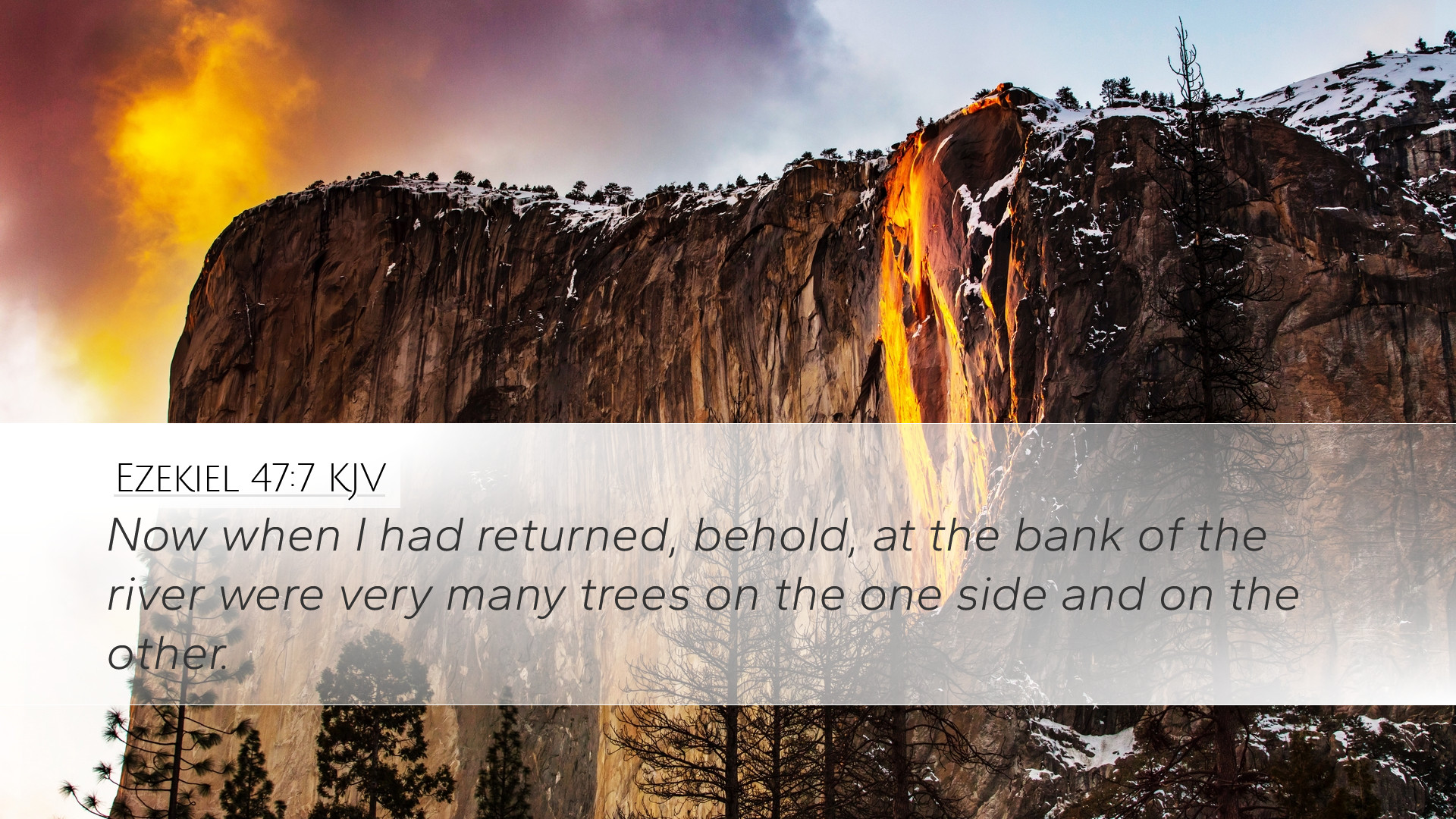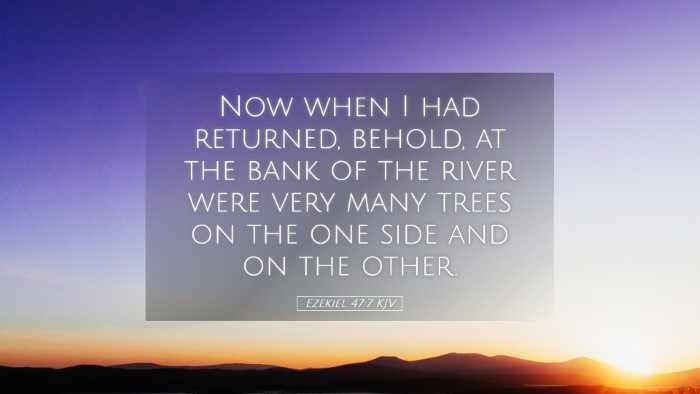Commentary on Ezekiel 47:7
Ezekiel 47:7 states:
"Now when I had returned, behold, at the bank of the river were very many trees on the one side and on the other." (Ezekiel 47:7, KJV)
Introduction
This verse is situated in the context of Ezekiel’s vision of the future temple and the life-giving waters flowing from it. In this profound imagery, the river symbolizes the grace and preservation that God provides to His people. The abundance of trees signifies life and prosperity, pointing to the spiritual sustenance that emanates from divine blessings.
The Significance of the River
Matthew Henry emphasizes the river as a metaphor for the blessings of God flowing into the lives of His people. Henry notes that this river brings healing and encourages growth. He draws a parallel to the spiritual river found in Revelation 22:1, which also represents God’s eternal provision and sustenance.
Albert Barnes suggests that the river signifies the outpouring of God's Spirit, which nourishes the soul and strengthens faith. The abundant trees are emblematic of believers who flourish through the Spirit’s work. They stand as a testimony to God’s life-giving presence in the midst of a barren world.
The Trees: Symbols of Abundance and Life
Adam Clarke details that the trees on either side of the river serve as a powerful illustration of the vitality and abundance found in God. He notes:
- Life: The trees bear fruit, ensuring nourishment for the people. This resonates with Psalm 1:3, which speaks of the righteous man, likened to a tree planted by rivers of water, yielding fruit in due season.
- Healing: The leaves of these trees are said to be for the healing of the nations (Ezekiel 47:12). Clarke underscores this, expanding on the idea that the provisions from God not only maintain life but restore and heal those who are afflicted.
- Growth: The multitude of trees represents the body of Christ, where various members contribute to the overall strength and vibrancy of the community.
Reflection on the Context
Ezekiel’s vision must be understood in light of Israel’s restoration. The prophet speaks to a people who had faced devastation and exile. The imagery he uses presents a contrasting reality—a revitalized landscape where the blessings of God supersede the previous desolation.
The water flowing from the temple indicates a new covenant, fulfilling God’s promise to restore Israel and bless all nations through Christ (John 7:38). In this light, the river is a symbol of spiritual renewal, cascading from the very presence of God.
Theological Implications
This passage invites theological reflection on the nature of God’s providence:
- Divine Generosity: The imagery of abundant trees invites believers to recognize God's generosity. He does not merely provide the bare minimum; rather, He gives abundantly for the nourishment and growth of His people.
- Interconnectedness: The river and the trees illustrate the interconnectedness of believers’ lives and God’s sustenance. Just as trees cannot thrive without the river, believers must remain connected to Christ, who is the source of all life (John 15:5).
- Eschatological Hope: This passage has eschatological significance, looking forward to the ultimate restoration and healing that will be realized in God’s kingdom. It assures believers that God’s redemptive plan encompasses every realm of existence and will culminate in perfect restoration.
Practical Application
For pastors, students, and theologians, this passage offers rich insights useful for teaching and discipleship:
- Encouragement in Trials: Believers can take comfort in knowing that, just as the trees thrive by the river, they too can find strength and sustenance in their relationship with God during trials.
- Call to Faithfulness: The flourishing of the trees serves as a reminder to remain faithful to God to experience His blessings fully. It invites reflection on our spiritual health and growth.
- Mission to Heal: Recognizing that the leaves are for healing prompts believers to engage in acts of service and love, extending God's healing to the broken world.
Conclusion
Ezekiel 47:7 encapsulates a vision of hope, life, and divine provision. The river's flow and the trees' abundance depict God’s desire to cultivate life and restoration in His creation. This passage serves as a potent reminder of the fruitful life available through faith in God and encourages believers to partake in His blessings and share them with others.


